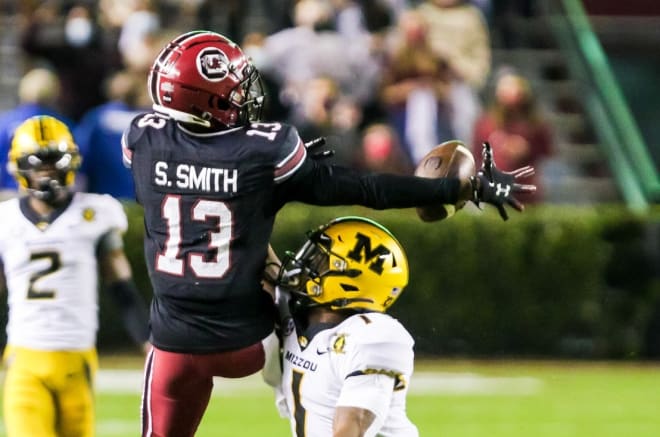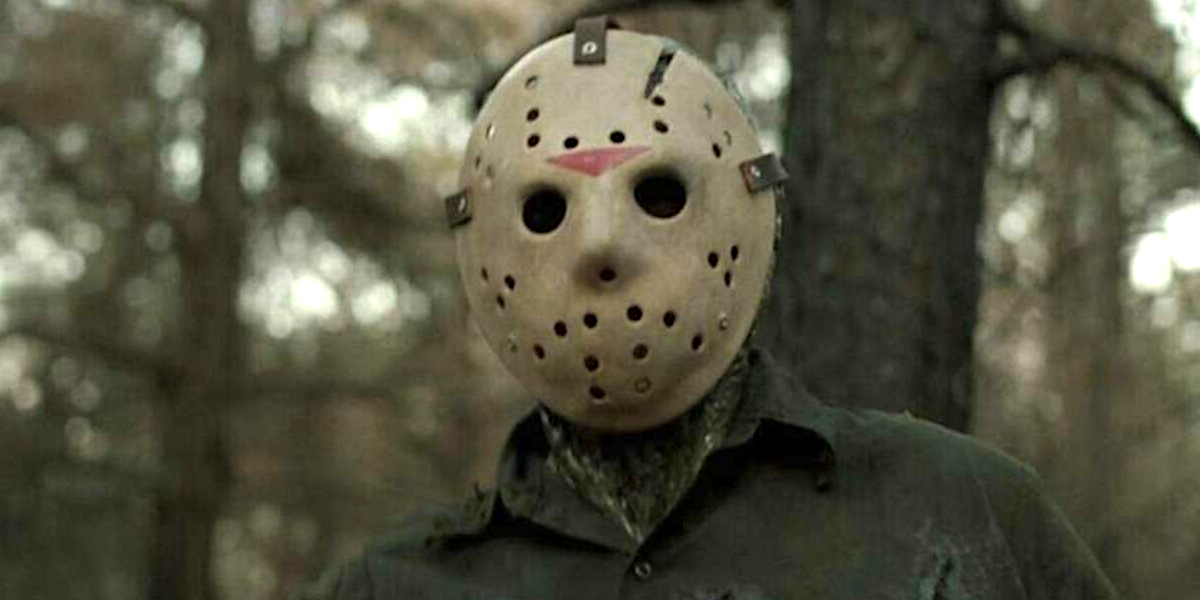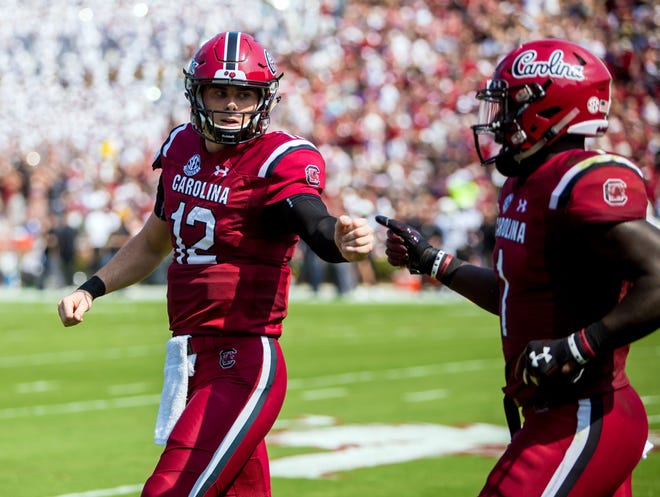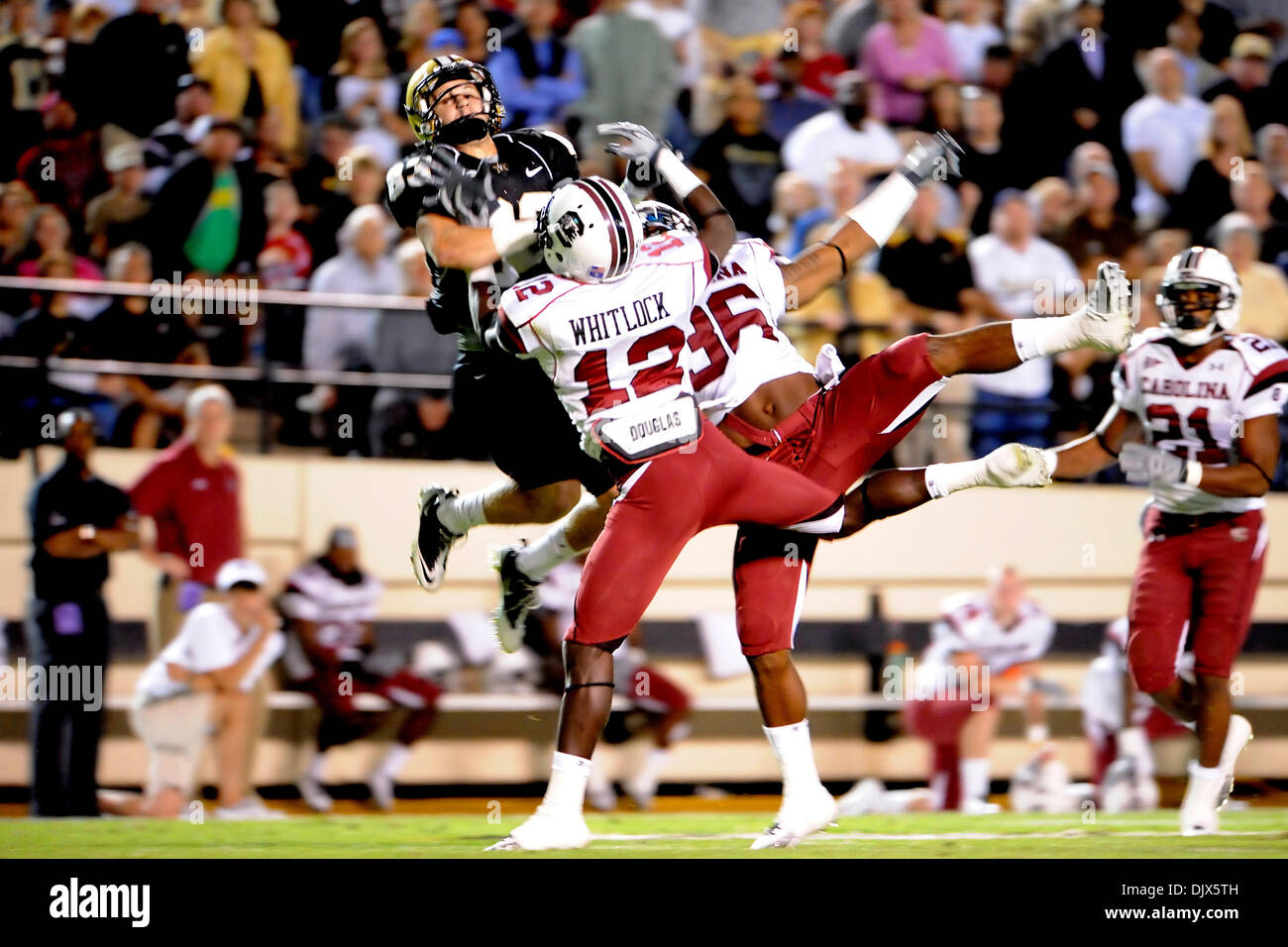Gamecock Fanatics
You are using an out of date browser. It may not display this or other websites correctly.
You should upgrade or use an alternative browser.
You should upgrade or use an alternative browser.
Countdown to Kickoff II: The Final 24 Days
- Thread starter Swayin
- Start date
USS Franklin, CV-13.
_underway_at_sea_on_1_August_1944_(80-G-367248).jpg/1280px-USS_Franklin_(CV-13)_underway_at_sea_on_1_August_1944_(80-G-367248).jpg)
_approaching_New_York,_April_1945.jpg/1280px-USS_Franklin_(CV-13)_approaching_New_York,_April_1945.jpg)
https://en.wikipedia.org/wiki/USS_Franklin_(CV-13)
_underway_at_sea_on_1_August_1944_(80-G-367248).jpg/1280px-USS_Franklin_(CV-13)_underway_at_sea_on_1_August_1944_(80-G-367248).jpg)
Franklin approaching New York, 26 April 1945 still showing the damage from the March 19th attack. (below)USS Franklin (CV/CVA/CVS-13, AVT-8), nicknamed "Big Ben," was one of 24 Essex-class aircraft carriers built during World War II for the United States Navy, and the fifth US Navy ship to bear the name. Commissioned in January 1944, she served in several campaigns in the Pacific War, earning four battle stars. She was badly damaged by a Japanese air attack in March 1945, with the loss of over 800 of her crew, becoming the most heavily damaged United States aircraft carrier to survive the war. Movie footage of the actual attack was included in the 1949 film Task Force starring Gary Cooper.
_afire_and_listing_after_a_Japanese_air_attack_on_19_March_1945_(80-G-273882).jpg/1280px-USS_Franklin_(CV-13)_afire_and_listing_after_a_Japanese_air_attack_on_19_March_1945_(80-G-273882).jpg)

After the attack, she returned to the U.S. mainland for repairs, missing the rest of the war; she was decommissioned in 1947. While in reserve, she was reclassified as an attack carrier (CVA), then an antisubmarine carrier (CVS), and finally an aircraft transport (AVT), but was never modernized and never saw active service again. Franklin and Bunker Hill (damaged by two kamikazes) were the only Essex-class carriers not to see active service as aircraft carriers after World War II.
When totaling casualty figures for both Franklin cruises numbers increase to 924 killed in action, the worst for any surviving U.S. warship and second only to that of battleship USS Arizona. Certainly, the casualty figures would have far exceeded this number, but for the work of many survivors. Among these were the Medal of Honor recipients Lieutenant Commander Joseph T. O'Callahan, the warship's Catholic chaplain, who administered the last rites, organized and directed firefighting and rescue parties, and led men below to wet down magazines that threatened to explode; and also Lieutenant Junior Grade Donald A. Gary, who discovered 300 men trapped in a blackened mess compartment and, finding an exit, returned repeatedly to lead groups to safety. Gary later organized and led fire-fighting parties to battle fires on the hangar deck and entered the No. 3 fireroom to raise steam in one boiler. USS Santa Fe rescued crewmen from the sea and approached Franklin to take off the numerous wounded and nonessential personnel. Among those evacuated were the surviving members of the embarked Air Group 5, who were deemed non-expendable.
Official Navy casualty figures for the 19 March 1945 fire totaled 724 killed and 265 wounded. Nevertheless, casualty numbers have been updated as new records are discovered. A recent count by Franklin historian and researcher Joseph A. Springer brings total 19 March 1945 casualty figures to 807 killed and more than 487 wounded. Franklin had suffered the most severe damage and highest casualties experienced by any U.S. fleet carrier that survived World War II. In addition to the Medals of Honor for Donald Gary and Joseph O'Callahan and the posthumous Navy Cross for George Fox, 21 additional Navy Crosses and 26 Silver Stars were awarded as a result of actions that day. Among these were a gold star in lieu of a third Navy Cross for CDR (later RADM) Joseph F. "Joe" Taylor, the ship's executive officer and a former torpedo bomber pilot,[23] and Navy Crosses for CAPT (later RADM) Harold C. Fitz, the Santa Fe commander, CDR Stephen Jurika, the Franklin navigator and also a former torpedo bomber pilot, LCDR (later RADM) Dwight L. Johnson, the Miller commander, LCDR Macgregor "Mac" Kilpatrick, an experienced fighter pilot and the commanding officer of Fighting Squadron Five, and LT Fred R. "Red" Harris, a Franklin flight deck officer and a member of the Texas Legislature both before and after the war. Among those who received Silver Stars were LT Grimes W. Gatlin, the ship's other chaplain and a Methodist minister, and Donald H. Russell, a civilian Vought F4U Corsair technical support engineer.
_approaching_New_York,_April_1945.jpg/1280px-USS_Franklin_(CV-13)_approaching_New_York,_April_1945.jpg)
https://en.wikipedia.org/wiki/USS_Franklin_(CV-13)
Last edited by a moderator:
Homebrewcock
GCF Top Poster
Homebrewcock
GCF Top Poster
Brinkley and Newton make a key sack at the end of the game. 1:57:02 mark.
Heroes!USS Franklin, CV-13.
Franklin approaching New York, 26 April 1945 still showing the damage from the March 19th attack. (below)
https://en.wikipedia.org/wiki/USS_Franklin_(CV-13)
The 13th Calvary Regiment (13th Horse)


The Regiment would stay on the border during World War I, but would trade it's horses for tanks in the years leading up to World War II and be re-designated the 13th Armored Regiment (Light) in June of 1940.The 13th Cavalry Regiment ("13th Horse") is a unit of the United States Army. The 2nd Squadron is currently stationed at Fort Bliss, Texas, as part of the 3rd Armored Brigade Combat Team, 1st Armored Division.
Border War
Punitive Expedition
Pancho Villa's raid on Columbus, New Mexico on 9 March 1916 was a casus belli in the eyes of US President Woodrow Wilson, and he ordered General John "Black Jack" Pershing to lead a Punitive Expedition into Mexico on 16 March 1916. Four cavalry regiments, two infantry regiments, and two batteries of artillery formed the main body of the expedition, and the 13th Cavalry was in the vanguard, taking point for the expedition.
In early April 1916, MAJ Frank Tompkins, who fought in the Battle of Columbus, persuaded GEN Pershing to allow him to lead 8 officers and 120 men of Troops K and M, 13th Cavalry, on a raid deep into Mexican territory. MAJ Tompkins' intentions were to chase and eventually engage the elusive rebels of Pancho Villa. After preparations were completed, the force left camp on 5 April. The Americans made a quick ride across the Mexican desert, traveling 85 miles in 50 hours. Following several days in the wilderness, MAJ Tompkins wrote; "We were ragged, shoes were gone and nearly everyone had a beard. We certainly presented a hard-boiled, savage appearance." The Americans were hoping to rest at the city of Parral for a day, and they were told they'd be welcome by a Carrancista (Mexican Constitutionalist) officer along the way. However, when the column arrived at Parral in the early morning of 12 April, the Carrancista commander of the city, General Ismael Lozano, informed MAJ Tompkins that coming to the city was a bad idea and that he must leave immediately. Tompkins agreed so the Americans left Parral not long after getting there.
On the way out of town, a group of Mexicans began shouting "Viva Villa", and other phrases, so MAJ Tompkins shouted the same back. A few minutes later, as the column was just outside town, a cavalry force of about 550 Carrancistas launched an attack on the American column. MAJ Tompkins had been betrayed. Within the first few shots a Sergeant standing next to Tompkins was hit and killed while a second man was seriously wounded. Heavily outnumbered, the 13th Cavalry had no choice but to keep going so they dismounted a rear guard to take up positions on a small hill and engage the pursuing Mexicans. In this first skirmish, an estimated 25 Mexicans were killed and the rest were driven off. The rear guard then regrouped with the main force where they withstood another attack. During the second skirmish, an estimated 45 Mexicans were killed. The Troopers continued their ride to Santa Cruz de Villegas, a fortified town, 8 miles from Parral, that the Americans could defend. The Cavalry reached their town, but the Mexicans were not far away, and MAJ Tompkins was facing the possibility of his 100-man force being besieged by hundreds of Carrancistas, so he sent out dispatch riders for reinforcements.
Just before 0800, a force of Buffalo Soldiers from the 10th Cavalry, arrived. They had recently engaged about 150 Villistas at the Battle of Agua Caliente on 1 April . Following the arrival of reinforcements, the Mexicans retreated back to Parral and there was no more fighting. Two Americans were killed in the battle and six others were wounded, including MAJ Tompkins. The enemy, however, suffered much greater losses. The Battle of Parral was a turning point in the Mexican Expedition, it marked America's furthest penetration into Mexico during the operation, 516 miles from the border, and marked the beginning of a slow withdrawal from Mexico which ended in early 1917. When General Pershing heard of the Carrancista government's betrayal, he was "mad as hell" and demanded a formal apology, but it never came. The 13th Cavalry Regiment's exceptional performance in America's last great mounted cavalry campaign earned it the special designation; 13th Horse.
The 13th Armored would go on to make a name for itself in the North Africa, slugging it out with Rommel at Kasserine Pass.Interbellum
The period between the Mexican Expedition and World War II was a tumultuous time for the 13th Cavalry. The United States entered World War I in April 1917, but the Regiment remained on the Mexican border and patrolled the area to protect against future raids. In 1921 it returned to Fort Riley, Kansas where it was key in developing the Army's future mechanized and armored force. The Troopers received M1 Combat Cars for their reconnaissance roles, but some remained mounted on horseback. In 1933, it was assigned to the 2nd Cavalry Division, and was soon transferred to the 7th Cavalry Brigade (Mechanized) at Fort Knox, Kentucky in 1936. Here, the troopers dismounted their loyal horses for the final time and went on to become a fully mechanized unit.
The 13th Cavalry, in their new vehicles, was sent to Pine Camp, New York to participate in some of the Army’s first ever mechanized warfare exercises. This training helped to identify the advantages and shortcomings of the Army’s new mechanized cavalry forces, and the 13th Cavalry played a major role in the Army’s modernization. On 15 June 1940, the 13th Cavalry Regiment was re-designated as the 13th Armored Regiment (Light) and was assigned to the newly formed 1st Armored Division. As a Light Armored Regiment, the 13th had an authorized complement of 91 Officers and 1,405 Enlisted Men, along with 82 M3 Scout Cars for reconnaissance, and 136 M3 Stuart Light Tanks. With the 1st AD, the 13th Armor (Light) participated in the Arkansas, Louisiana, and Carolina Maneuvers of 1941, which were the Army’s first training exercises in large-scale armored warfare.

These maneuvers helped the Army’s fledgling mechanized force identify its strengths and weaknesses, and helped the Army develop new strategies and tactics regarding the implementation of armored units, and how to coordinate between reconnaissance, armor, infantry, and artillery for combined arms maneuver. In this regard, the 13th Armored Regiment (Light) was a true pioneer in the development of the US Army's Armor Branch. On 7 December 1941, the Regiment was re-designated as the 13th Armored Regiment after it received larger tanks and underwent a significant reorganization; 1st Battalion consisted of the M3 Stuart light tanks and was used in a reconnaissance and security role. 2nd and 3rd Battalions consisted of M3 Lee medium tanks for use in direct action.
That same day, 7 December 1941, the Empire of Japan attacked Pearl Harbor, thrusting the United States into World War II. On 11 December, Nazi Germany and Fascist Italy declared war on the United States as well, thus setting the stage for America's involvement in a two-front war. The men of the 13th Armored Regiment would not have long to wait until they could test their newfound skills as an armored force in battle.
The 13th would next fight in the Italian campaign.The Germans were eventually stopped by the remnants of 2-13 and 3-13 Armor near Thala on 22 February. Although the enemy had pushed back the Allies, they were tired and spread thin. The Allied counter strike culminated at the Battles of El Guettar and Mateur, where tankers from 13th Armor showed the Germans that they had learned from their early mistakes, and were capable of fighting, and winning against the best. In early May 1943, one week before German forces in Africa ceased resistance, 2nd Battalion, 13th Armored Regiment was poised to take the seaside town of Bizerte.
During the push to the city, 1LT Dwight Varner, from Piatt County, Illinois and a recent graduate of the University of Illinois, was leading his platoon in the attack, when his tank and eight others were knocked out by German anti-tank guns. 1LT Varner escaped his burning tank and managed to drag several crewmen to safety and provide first aid. However, he was wounded and captured. While marching to Tunis, he managed to escape his captors after three days and 40 miles of marching. Upon encountering seven Italian soldiers, he turned the tables and captured them by bluffing that the mess kit spoon in his pocket was a pistol. Commandeering the enemy’s vehicle, he then captured 18 unsuspecting Germans and drove them all back to American lines. 1LT Varner was awarded the Distinguished Service Cross for extreme gallantry and risk of his life while facing the enemy.
https://en.wikipedia.org/wiki/13th_Cavalry_RegimentDuring the Battle of Anzio, the 13th Armored Regiment saw its first real combat in the Italian Campaign. Although the fighting here was difficult and not ideal for armored warfare, the 13th Armor secured an Allied breakthrough and helped end the stalemate in Southern Italy. Rome, the Italian capital, was finally within reach.
Rome-Arno
After achieving a breakout from the Anzio beachhead, 1st Armored Division tanks were positioned just south of Rome by 2 June 1944. Allied planners wanted to waste no time, and immediately ordered the tanks of the 13th Armored Regiment to advance to the “Eternal City.” LTC Cairns’ 3rd Battalion 13th Armor, part of Task Force Howze, led the way down Highway 6.

CCB and TF Howze became adept at defeating German armored elements, and the Arno River was finally reached on 18 July 1944, but the 1st Armored Division needed a rest. After pulling back, the Division was completely reorganized on 20 July. The 13th Armored Regiment was reduced in size and was re-designated as the 13th Tank Battalion. 1-13 Armor was disbanded, and its tanks and crews went on to replace others lost in combat. Companies D, E, and F of 2-13 Armor became Companies A, B, and C of the 13th Tank Battalion (M4 Shermans). B Co of 1st Armored Regiment became D Co, 13th Tank Battalion (M5 Stuarts). Companies G, H, and I of 3-13 Armor left and formed the 4th Tank Battalion. The 13th Tank Battalion soon began preparing to meet the next formidable German defensive position; the Gothic Line.
Last edited by a moderator:
My was a big fan of Andy Williams back in the day. Dude just had a great set of pipes.
The 12-string guitar. None better than The Byrds.

/cloudfront-us-east-1.images.arcpublishing.com/gray/EBYEB423JJAIPEO2AXZZFWPVPU.jpg)












